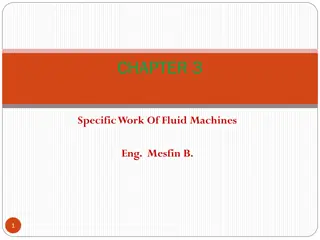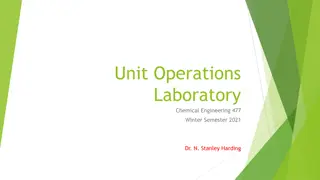
Dynamic Memory Management & File Handling in Programming
Understanding the concepts of dynamic memory allocation, file handling, and pointer management is crucial in programming. This content covers topics like NULL pointers, opening/closing files, and working with data structures. Explore these fundamental aspects to enhance your programming skills.
Download Presentation

Please find below an Image/Link to download the presentation.
The content on the website is provided AS IS for your information and personal use only. It may not be sold, licensed, or shared on other websites without obtaining consent from the author. If you encounter any issues during the download, it is possible that the publisher has removed the file from their server.
You are allowed to download the files provided on this website for personal or commercial use, subject to the condition that they are used lawfully. All files are the property of their respective owners.
The content on the website is provided AS IS for your information and personal use only. It may not be sold, licensed, or shared on other websites without obtaining consent from the author.
E N D
Presentation Transcript
PROGRAMMING II( Dynamic Memory I) Vladimir Viies, Lembit J rim gi,Risto Heinsaar, Trevor Kallaste vladimir.viies@gmail.com Tallinn 2020
Opening a file Working with files requires us to use file pointers To declare a file pointer: FILE *fp; To open a file: filePointer = fopen(fileName, mode); Both filename and mode are type char* (char pointers aka strings) File pointer will be set to NULL when opening files You should always verify that the file was opened successfully 2016 3
NULL pointer A pointer that does not refer to a valid object Behavior undefined Often used to indicate pointers not in use or failed operations End of a list (advanced data structures) Memory allocation failed (dynamic memory management) Opening file failed Search for substring failed (strstr from string.h) Assigning pointer to NULL avoids unintentional access to released resources May lead to segmentation fault when accessed NULL is a pointer, 0 is an integer. NULL pointer may not always be zero, but typically is. 2016 4
Code example You should always check if the file was successfully opened When opening of the file fails, reading from it will crash the program. FILE *fi;// file pointer declaration char inputFile[] = {"numbers.txt"}; fi = fopen(inputFile,"r");//opening file if (fi == NULL) // check for errors { exit(1); // abort. Exit comes from stdlib.h } 2016 5
Closing a file Resources should be freed when not needed All of the files should be closed before exiting When writing, any files not closed may have parts or all of the content missing from it. Closing writes the output still in buffer to the file. Especially important when writing log files and the program crashes. To close a file: fclose(filePointer); 2016 6
STRUCTURES Complex data type It consist of other data types (int, char, float etc) typedef struct employee { int employeeCode; char firstName[15]; char lastName[15]; float salary; } employee;
Structure in the memory struct employee { int employeeCode; char firstName[15]; char lastName[15]; float salary; }; 0 4 19 36 39 emplCo firstName lastName salary Structure size in memory = the size of its members + padding In this case, the structure is 38 bytes + padding 2016 9
Accessing structure members Stucture member names are united by points with the structure variable name. structureVariableName.memberName manager.salary = 15.5; printf("%f", manager.salary); employees[5].salary = manager.salary; strcpy(employees[5].firstName, "Indrek"); You can assign structures as a whole employee manager, staff[20],employees[10]; employees[0] = manager; employees[5] = staff[15]; 2016 10
Nested structures You can put one structure inside of another typedef struct date { unsigned day; unsigned month; unsigned year; } date; typedef struct person { char fName[15]; char lName[15]; date contractSigned; } person; The order they re defined is important 2016 11
Function returning a structure Reminder: structure was a data type, albeit a complex one. This means that we can also use it as a return type for a function. We can return one whole structure per function call. We could also return a structure pointer as we ll see in a few weeks typedef struct point { int x, y; } point; A prototype for a function point enterPoint() point enterPoint(){ point temporary; temporary.x = 5; temporary.y = 7; return temporary; } 2016 12
Pointers and arrays visualized int array[] = {5, 3, 7, 3, 5}; int *p; p = array; *p 48F9AC9 1 array[0] array[1] array[2] array[3] array[4] 5 3 7 3 5 *(p + 0) *(p + 1) *(p + 2) *(p + 4) *(p + 3) 2016 13
Pointers and structures You can point to the start of a structure or an element inside it. typedef struct employee{ int employeeCode; char firstName[15]; char lastName[15]; float salary; } employee; employee manager; employee *pStr; pStr = &manager; 2016 14
Accessing members using pointers Both of these are equal (*pStr).employeeCode; (*pStr).fName; (*pStr).lName; (*pStr).salary; pStr->employeeCode; pStr->fName; pStr->lName; pStr->salary; 2016 15
Dynamic allocation (references) A. D. Marshall. Programming in C. UNIX System Calls and Subroutines using C. http://www.cs.cf.ac.uk/Dave/C/CE.html The cplusplus.com tutorial. Complete C++ language tutorial http://www.cplusplus.com/doc/tutorial/index.html The GNU C library http://www.gnu.org/software/libc/manual/html_node/
Dynamic allocation I Dynamic allocation is a pretty unique feature to C (amongst high level languages) It enables us to create data types and structures of any size and length to suit our programs need within the program
Dynamic allocation II Two common applications of dynamic memory: dynamic arrays dynamic data structure e.g. linked lists
Function malloc() The Functionmalloc is most commonly used to attempt to hod or snap a continuous portion of memory. It is defined by: void *malloc(size_t number_of_bytes) That is to say it returns a pointer of type void * that is the start in memory of the reserved portion of size number_of_bytes. If memory cannot be allocated a NULL pointer is returned. Since a void * is returned the C standard states that this pointer can be converted to any type. The size_t argument type is defined in stdlib.h and is an unsigned type. So: char *cp; cp = malloc(100);
Functione sizeof() I It is usual to use the sizeof() function to specify the number of bytes: int *ip; ip = (int *) malloc(100*sizeof(int)); Some C compilers may require to cast the type of conversion. The (int *) means coercion to an integer pointer.
Functione sizeof() II It is good practice to use sizeof() even if you know the actual size you want -- it makes for device independent (portable) code. independent (portable) code. Sizeof can be used to find the size of any data type, variable or structure. Simply supply one of these as an argument to the function: int i; struct COORD {float x,y,z}; typedef struct COORD PT; sizeof(int), sizeof(i), sizeof(struct COORD) , sizeof(PT) are all ACCEPTABLE it makes for device
Function free() When you have finished using a portion of memory you should always free() int * int * buffer1; buffer1; buffer1 buffer1 = (int*) malloc (100*sizeof(int = (int*) malloc (100*sizeof(int)); ................... ................... free free (buffer1); (buffer1); This allows the memory freed again, possibly for further possibly for further malloc() The function free() takes a pointer as an argument and frees the memory to which the pointer refers. free() it. )); freed to be aavailable malloc() calls.
Example malloc+sizeof+free #include <stdio.h> #include <stdlib.h> int main () { int i,n; int * pData; printf ("Amount of numbers to be entered: "); scanf ("%d",&i); pData = (int*) malloc (i*sizeof(int)); for (n=0;n<i;n++) printf ("%d ",pData[n]); if (pData==NULL) exit (1); for (n=0;n<i;n++) { printf ("Enter number #%d: ",n); scanf ("%d",&pData[n]); printf ("%d \n",pData+n); } printf ("You have entered: "); for (n=0;n<i;n++) printf ("%d ",pData[n]); free (pData); printf ("After free:\n "); for (n=0;n<i;n++) printf ("%2d %d \n",pData[n],pData+n); getchar(); getchar(); return 0; }
Function calloc() void *calloc(size_t num_elements, size_t element_size}; Malloc Malloc does not initialise memory (to zero) in any way. If you wish to initialise memory then use calloc calloc. Calloc there is slightly more computationally expensive but, occasionally,more convenient than malloc. Also note the different syntax between calloc calloc and malloc malloc in that calloc the number of desired elements, num_elements num_elements, and element_size, element_size element_size, as two individual arguments. calloc takes
Example calloc+sizeof+free #include <stdio.h> #include <stdlib.h> int main () { int i,n; int * pData; printf ("Amount of numbers to be entered: "); scanf ("%d",&i); pData = (int*) calloc (i,sizeof(int)); for (n=0;n<i;n++) printf ("%d \n",pData[n]); if (pData==NULL) exit (1); for (n=0;n<i;n++) { printf ("Enter number #%d: ",n); scanf ("%d",&pData[n]); } printf ("You have entered:\n "); for (n=0;n<i;n++) printf ("%2d %d\n",pData[n],pData+n); free (pData); printf ("After free:\n "); for (n=0;n<i;n++) printf ("%2d %d \n",pData[n],pData+n); getchar(); getchar(); return 0; }
Function realoc() void *realloc( void *ptr, size_t new_size); Realloc is a function which attempts to change the size of a previous allocated block of memory. The new size can be larger or smaller. If the block is made larger then the old contents remain unchanged and memory is added to the end of the block. If the size is made smaller then the remaining contents are unchanged.
Example realoc+sizeof+free #include <stdio.h> #include <stdlib.h> int main () { int input,n; int count=0; int * numbers = NULL; int * more_numbers; do { printf ("Enter an integer value (0 to end): "); scanf ("%d", &input); count++; more_numbers = (int*) realloc (numbers, count * sizeof(int)); if (more_numbers!=NULL) { numbers=more_numbers; numbers[count-1]=input; } else { free (numbers); puts ("Error (re)allocating memory"); exit (1); } } while (input!=0); printf ("Numbers entered: \n"); for (n=0;n<count;n++) printf ("%d %d\n",numbers[n],numbers+n); free (numbers); printf ("After free: \n"); for (n=0;n<count;n++) printf ("%d %d\n",numbers[n],numbers+n); getchar(); getchar(); return 0; }
Recursion in C In C programming language, when a function calls itself over and over again, that function is known as recursive function. Recursion is the process of repeating items in a self-similar way . Process of function calling itself repeatedly is known as recursion.
Recursion In programming languages, if a program allows you to call a function inside the same function, then it is called a recursive call of the function. void recursion() { recursion(); /* function calls itself */ } int main() { recursion(); return; } The C programming language supports recursion, i.e., a function to call itself. But while using recursion, programmers need to be careful to define an exit condition from the function, otherwise it will go into an infinite loop.
Bad recursion example #include <stdio.h> void func(void) { printf("\n This is a recursive function \n"); func(); } int main(void) {int n, i=5; for (n=0;n<i;n++) {printf (" %d\n",n); func(); return 0; }
Factorial example #include <stdio.h> int func(int num) { int res = 0; if(num <= 0) { printf("\n Error \n");} else if(num == 1) { return num; } else { res = num * func(num -1); return res; } return -1; } int main(void) { int num = 5 ; int fact = func(num); if (fact > 0) printf("\n The factorial of [%d] is [%d]\n", num, fact); return 0; }
Fibonaci example #include <stdio.h> int fibonaci(int i) { if(i == 0) { return 0; } if(i == 1) { return 1; } return fibonaci(i-1) + fibonaci(i-2); } int main() { int i; for (i = 0; i < 10; i++) { printf("%d\t\n", fibonaci(i)); } return 0; }
DM example #include <stdio.h> #include <stdlib.h> #include <assert.h> void stat(int k){ int M[k]; printf("%p %lu\n", M, sizeof(M)); } void dyn(int k){ double *M; M = malloc(k * sizeof(double)); assert(M != NULL); //vaja kontrollida, kas m lueraldus nnestus printf("%p %lu %lu\n", M, sizeof(M), k * sizeof(double)); free(M); } double *dyn2(double *M, int k){ double *X; X = realloc(M, k * sizeof(double)); assert(X != NULL); printf("%p %p %lu\n", M, X, k * sizeof(double)); int i; for(i = 0; i < rand() % k; i++) X[rand() % k] = rand(); //selleks, et m lu ka kasutusel oleks return X; } int main(void){ int x = 100; double *D = NULL; while(1){ stat(x); dyn(x); //D = dyn2(D, x); getchar(); x = x * 1.2; } }
Recursion example #include <stdio.h> int add(int k){ int a; printf("%d %d\n", k, a); if(k > 1) a = k + add(k - 1); else a = 1; printf("%p %p %d %d\n", &k, &a, k, a); return a; } int mul(int k){ int a; printf("%d %d\n", k, a); if(k > 1) a = k * mul(k - 1); else a = 1; printf("%p %p %d %d\n", &k, &a, k, a); return a; } int main(void){ mul(5); add(5); return 0; }
Bonus task I Write a program to sort a sequence of numbers using a binary tree (Using Pointers). A binary tree is a tree structure with only two (possible) branches from each node (Fig. 1). Each branch then represents a false or true decision. To sort numbers simply assign the left branch to take numbers less than the node number and the right branch any other number (greater than or equal to). To obtain a sorted list simply search the tree in a depth first fashion.
HOMEPAGE: http://www.tud.ttu.ee/im/Vladimir.Viies/






















